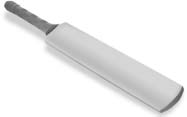
The death Holding dished out to Boycott was slow, agonising and merciless
If Shane Warne is famous for having bowled the ‘Ball of the Century’ to Mike Gatting in 1993, then the accolade of ‘Over of the Century’ belongs to Michael Holding. They called the West Indian paceman ‘Whispering Death’, and the death he dished out to Geoff Boycott in Bridgetown, Barbados, on the afternoon of Saturday 14 March 1981 was slow, agonising and merciless.
So this object, a stump, is in honour of Holding, and in honour of Boycott, who did well to survive as long as he did.
Holding had previous when it came to petrifying batsmen, as Trevor Bailey wrote in 1983, in From Larwood to Lillee, a study of great fast bowlers. ‘One of the greatest, possibly the greatest, piece of sustained fast bowling it has been my privilege to witness was by Michael Holding in the 1976 Test at the Oval,’ said Bailey, who knew a few things about pace, having played against Ray Lindwall, the Aussie quick they dubbed ‘Killer’. In that match, played on a featherbed track, Holding finished with figures of fourteen for 149, the best bowling figures in a Test by a West Indian.
Bailey was there in Barbados in March 1981, peeking out from between his fingers as Boycott was tortured by Holding. ‘It was one of the very few occasions when I was rather glad that I was no longer playing Test cricket,’ commented Bailey.
Also watching from the press box that day was Paul Weaver, who relived the over in an article for the Guardian thirteen years later. The first ball hit Boycott in the chest. Holding turned, ambled calmly back to his mark and ran in again, roared on by a packed George Challenor Stand at the Kennington Oval. ‘To the second and third deliveries he played and missed as the ball whistled through to David Murray,’ recalled Weaver. ‘The fourth crashed into his thigh pad.’
Watching dumbstruck from the non-striker’s end was Graham Gooch. ‘It was 0–90mph in about 3.2 seconds,’ he said later. ‘Boycs took several blows to the gloves and ribs.’
Weaver described Holding’s fifth ball as ‘a savage snotball’ that almost decapitated the Englishman. By now Boycott was befuddled. ‘I never laid bat on ball,’ he said years later in a television interview with ESPN. ‘One ball hit me in the chest, one on top of the thigh. I missed a ball. Two I gloved out of neck, and then he knocked my off stump over.’
Gooch recalled that the stump ended up twenty yards from the wicket as Boycott stood stunned in his crease. ‘Boycott looked round,’ wrote Frank Keating, ‘then as the din assailed his ears, his mouth gaped and he tottered as if he’d seen the Devil himself. Then slowly he walked away, erect and brave and beaten.’

The death Holding dished out to Boycott was slow, agonising and merciless
Boycott spent the rest of the day slumped in the dressing room, his senses slowly recalibrating. At the close of play he went to the press box and watched a replay of how he’d been hung, drawn and quartered by Holding. Satisfied with what he saw, he retired to his room almost content, writing in his tour diary: ‘For the first time in my life, I can look at a scoreboard with a duck against my name and not feel a profound sense of failure.’
Boycott had simply been put to the sword by a great piece of bowling, by a man he later described as ‘a truly great bowler’. Yet in the list of Test-cricket bowling records, Holding comes beneath some of those other great quicks from the Caribbean – Malcolm Marshall, Joel Garner, Curtly Ambrose and Colin Croft. They may have been more economical than Holding with his average of a wicket for every 23.68 runs conceded, but none of them ever produced overs like the one he served up to Boycott – six balls that shook the world. They may not have been as dashing as the six that turned Garry Sobers into a legend, but they were a hell of a lot deadlier.